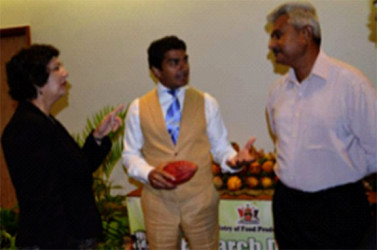(Trinidad Express) The thrust to make cocoa king again has taken a new direction with the official launch of Trinidad and Tobago’s first cocoa-processing facility, the Trinidad and Tobago Fine Cocoa Company Ltd Factory.

The factory, located at La Reunion Estate in Centeno, was established through a public-private partnership between the Government and 41-year-old Trinidad-born businessman Ashley Parasram.
Local cocoa farmers could benefit from the venture, as cocoa beans will be bought from them and processed into cocoa liquor (unsweetened baking chocolate), which would then be sold exclusively to UK-based Artisan du Chocolate to be made into fine chocolate products with six flavours.
The factory can process 50 metric tonnes of cocoa beans per year and has the potential to process up to 150 metric tonnes by 2017.
Speaking at Tuesday’s launch of the factory at the Hilton Trinidad, St Ann’s, Food Production Minister Devant Maharaj said it was the first venture which sought to monetise the cocoa industry. “We research cocoa to death in this country. There are shelves and shelves of research packed away when we were not able to monetise that research,” he said.
He said while the country boasts of producing one of the best cocoas in the world, cocoa farmers are still going home with less money. “So we could pat ourselves on the shoulder as much as we want, but the bank account continues to drop and, as a result of that, cocoa plantations are being abandoned.
“If you open a newspaper today, you could buy a plantation for $5 million because it is simply not economic at this time,” Maharaj said.
He said over the last 24 years, cocoa production had dropped significantly. He noted that in 1990, a total of 2,100 metric tonnes of cocoa were produced, but this dropped to 1,600 tonnes in 2000; then to 950 tonnes in 2010; and 350 tonnes last year.
Maharaj noted the decline in production was also linked to the reduction in the number of cocoa farmers—from 1,435 farmers in 2006 to 832 last year.
He pointed out the public-private partnership with the Fine Cocoa Company symbolised a renewed sense of hope in the cocoa industry.
He later told the Express the ministry provided the company with land space and a building for the factory, while the company took out loans to buy the necessary cocoa-processing equipment.
Parasram, who is a former UK development specialist, explained that two and a half years was spent on research and planning for the factory.
He said initial investment in the factory was $5 million, with $3 million going toward the purchase of state-of-the-art equipment from Brazil.


